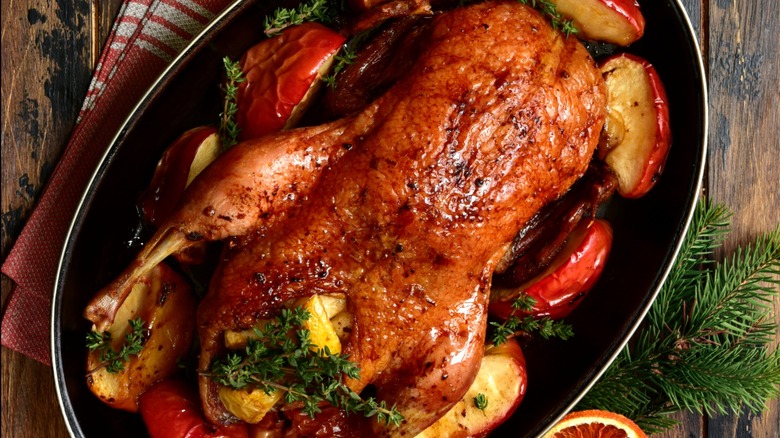The Prep Tip For Easily Cutting Roast Goose
A roast goose is a dish that wows. In order to ensure that a whole goose remains just as stunning as it is when it's first pulled from the oven, knowing how to properly carve the bird is essential. Rather than wrestle and wrangle with the poultry, there's a prep step that can make slicing up a roast goose much simpler.
Goose doesn't make a frequent appearance on many dinner tables, which is why you're probably not well-versed in handling the poultry. The good news is that a roast goose can be carved much like you would carve a whole turkey. The not-so-good news is that the bird can be harder to handle based on its larger size and tougher bones. As a result, breaking down the bird into visually presentable pieces is often easier said than done. But there is a way to make carving less complicated; all you need to do is dislocate the bird's joints prior to roasting.
Although some swear by completely butchering the bird into pieces to guarantee that all parts from breast to legs are juicy, this rids a whole goose of its aesthetic appeal. Instead, the technique of twisting and turning the goose's wings and legs in opposite directions works to breaks down the bird while keeping it visually intact. That said, since most of the hard work of cutting through the joints has already been done, carving the cooked goose also becomes incredibly easy.
The dos and don'ts of carving roast goose
With the goose properly prepped and roasted to perfection, give the bird a chance to rest before you reach for your carving knife. Doing this will allow all of those succulent juices to be reabsorbed, for the tastiest bite. After the 30 minute mark, you can move the goose onto a sturdy cutting board (breast-side up), and get to work.
Using a dedicated carving knife, start by removing the wings. Following the dislocation prep tip, they should separate fairly easily. Next, move your attention to the lower part of the bird. Make a cut through the leg joint to release the drumstick and thigh from the body, before separating the two sections — again, these pieces should detach effortlessly, thanks to the previous prep work of twisting and turning them in opposite directions. Lastly, the breast meat can be tackled. Cut along the curve of the breast bone to remove the meat from the carcass, repeating the process on the other side. Finish by slicing the breast into thin medallions, and adding all of the carved goose onto a platter to serve.
Given that most of the goose meat should fall off the bone, leaving you with a relatively clean carcass, don't discard anything! Save the near-spotless carcass along with any giblets so that you can make a savory stock. Just like that, nothing will go to waste — not any bones, nor any meat from a tricky-to-carve goose!

